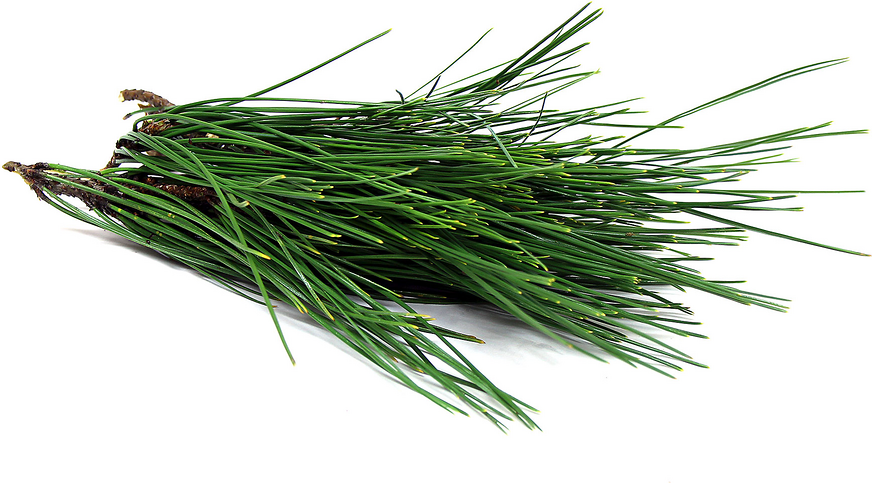


Pine Needles
Estimated Inventory, lb : 0
Description/Taste
Pine Needles are the slender, sharp leaves that grow on pine trees. Given the diversity of pine species, the size of Pine Needles typically ranges from 7.5 to 13 centimeters in length. Characteristically needle-shaped, they usually form in clusters of two to five and grow in various directions on their branches. The color of Pine Needles can vary from a deep forest green to a yellow-green. They have a slightly stiff texture that helps them resist bending. Smooth to the touch except at their pointy ends, Pine Needles also have a slightly waxy coating that helps them hold onto water. Pine Needles emit a strong, fresh, and clean scent that is distinctly resinous and strongly associated with forest environments. This scent is woody and a bit balsamic, with a touch of earthiness that gets stronger when the needles are crushed. This characteristic smell arises from the natural oils and sap within the needles. Pine Needles taste sharply resinous with a slightly sour and tangy kick.
Seasons/Availability
In the wild, Pine Needles can be foraged year-round.
Current Facts
Pine Trees mainly fall into two subgroups of the Pinaceae family: Pinus and Strobus. There are over 100 species, including Eastern White Pine, Scots Pine, and Ponderosa Pine. Pine Needles play a crucial role in their native ecosystems by forming a protective layer on the forest floor, which helps conserve moisture and protects against erosion. In more domestic settings, Pine Needles can be used as mulch to help soil retain moisture, added to compost piles to enrich the soil, and used to create natural dyes for fabrics. They can also be used for teas and essential oils with antiseptic and anti-inflammatory properties that can help reduce infection and swelling. Pine Needles are energizing, making them particularly beneficial for people with respiratory issues as they can help ease breathing difficulties. To make a tincture, gather fresh Pine Needles, cover them with alcohol in a 1:2 ratio, and let them soak for three weeks. Afterwards, strain the mixture using a mesh strainer or cheesecloth to remove the Pine Needles.
Nutritional Value
Pine Needles are packed with Vitamin C, which is why the tea made from them was once used to prevent scurvy. They can help alleviate congestion, thanks to compounds like alpha-pinene and limonene that have antimicrobial effects to reduce germs that cause respiratory infections. Pine Needles contain flavonoids and phenolic acids, known for their anti-viral and anti-carcinogenic properties. These compounds may protect against viruses and help reduce cancer risk by inhibiting viral replication and preventing cancer cell growth. To tap into these benefits, consider drinking Pine Needle tea, using tinctures, oils, and creams infused with Pine Needles, or taking Pine Needle supplements.
Applications
Pine Needles are edible and have been used for centuries, but they should be consumed with caution and in moderation as they can be hard to digest. Edible needles are usually bright green and found on young trees, tasting slightly sour or tangy with a strong pine smell. Avoid yellow or brown needles, as they may be rotten or diseased. Pine Needles are commonly used to make oils and teas or transformed into simple syrup for cocktails. They can be chopped and boiled with cream for ice cream or ground with flour and sugar for baking. Pine Needles can be used similarly to applewood or mahogany for smoking meats or chicken in fires. They can be placed under fish while cooking or chopped like rosemary for marinades or brines. Pine Needle oil can be used in sauces, salad dressings, roasted vegetables, and pasta. Pine Needles complement the flavors of rosemary, thyme, juniper berries, cinnamon, honey, ginger, maple, lemon, and orange. They pair well with foods like blueberries, raspberries, blackberries, apples, almonds, walnuts, pecans, mushrooms, pork, and poultry.
Ethnic/Cultural Info
Pine Trees hold profound spiritual importance in many cultures and traditions. Burning Pine Needles with resin is commonly used to cleanse spaces, as the smoke provides a grounding effect that’s believed to restore and rejuvenate energy. This makes it ideal for spiritual practices focused on healing and protection. Pine is also significant in the Ogham, an ancient Celtic alphabet and divination system used for communication and spiritual purposes. In the Ogham, pine is linked to the symbol Ailm, representing strength, fertility, health, and purity.
Geography/History
Pine Trees are native to the Northern Hemisphere and can be found in regions of North America, Europe, Russia, the Himalayas, China, and Japan. Commonly found in forests and mountainous areas, Pine Trees’ economic viability has led to their widespread cultivation for timber, paper, and other wood products. This commercial value, coupled with their aesthetic appeal and ease of growth, has facilitated their introduction into non-native areas of Australia, New Zealand, and Central and South America. Pine Needles are most often found in the wild but are also prevalent in gardens, parks, and urban settings. Because Pine Trees grow worldwide, their needles are not typically sold as standalone items in grocery stores or farmers' markets. Products infused with Pine Needles, like teas, essential oils, or herbal supplements, are available in health stores and specialty shops.
Recipe Ideas
Recipes that include Pine Needles. One
| Spoon University |
|
White Pine Needle Shortbread Cookies |
| Cooked |
|
Pine, Pancakes & Pollen |
| Herb Geek |
|
Evergreen Syrup |




